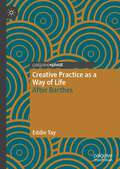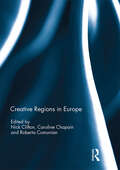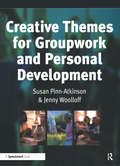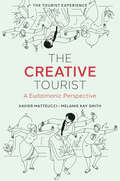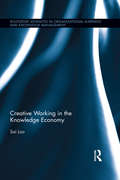- Table View
- List View
The Creative Power: Transforming Ourselves, Our Organizations, and Our World
by William E. SmithOver the last two decades a major focus of organization theory has been on understanding the dynamic relationships between individuals, organizations and their environments. This interest in dynamics, illustrated by systems, chaos, and complexity theory, is recorded in the works of Ackoff, Senge, and Stacey. This focus offers a new viewpoint on holism for practising leaders and theorists today. Building on this interest, Smith’s original text presents a new philosophical lens for helping leaders see the advantages of a more holistic approach to improving organizations. Specifically he: introduces the AIC (appreciation, influence, control) philosophy, model, and process of purpose-power relationships as a next step in the evolution of organization and systems theory traces its roots and evolution in organization theory and indicates its actual and potential contribution to that field translates the model into a transformative, strategic organizing process that can be used to organize at any level, in a way that will ensure the achievement of higher levels of purpose, at less cost and in less time than traditional organizational approaches. Developed and tested via his work for organizations including the World Bank, this revolutionary book will change the way organizations and individuals work.
The Creative Power: Transforming Ourselves, Our Organizations, and Our World
by William E. SmithOver the last two decades a major focus of organization theory has been on understanding the dynamic relationships between individuals, organizations and their environments. This interest in dynamics, illustrated by systems, chaos, and complexity theory, is recorded in the works of Ackoff, Senge, and Stacey. This focus offers a new viewpoint on holism for practising leaders and theorists today. Building on this interest, Smith’s original text presents a new philosophical lens for helping leaders see the advantages of a more holistic approach to improving organizations. Specifically he: introduces the AIC (appreciation, influence, control) philosophy, model, and process of purpose-power relationships as a next step in the evolution of organization and systems theory traces its roots and evolution in organization theory and indicates its actual and potential contribution to that field translates the model into a transformative, strategic organizing process that can be used to organize at any level, in a way that will ensure the achievement of higher levels of purpose, at less cost and in less time than traditional organizational approaches. Developed and tested via his work for organizations including the World Bank, this revolutionary book will change the way organizations and individuals work.
Creative Practice as a Way of Life: After Barthes (Palgrave Studies in Creativity and Culture)
by Eddie TayThis book combines autoethnographic reflections, poetry, and photography with the aim to bridge the gap between creative practice and scholarly research. Drawing on an innovative combination of different forms of knowledge, creative writing and street photographs are presented as means to reflect on the development of knowledge and self-knowledge through a thought-provoking dialogue with Roland Barthes’ post-structuralist work. What does it mean to be a creative practitioner in a world traversed by values of capitalism and artificial intelligence? What does it mean to teach creative practices in such an environment?The urban landscape of Singapore, with the Jewel Changi mall, the Universal Studios, and Little India in the background, is the stage where the capitalist demands of modern city life grapple with the solitary act of writing poetry and taking photographs through the personal experience of the author. Capitalist realism and depression realism entwine with Barthes' notion of vita nova in a mesmerizing phantasmagoria that drags the reader to the bowels and secret pleasures of the creative process.
Creative Regions in Europe
by Nick Clifton Caroline Chapain Roberta ComunianCreative and cultural industries, broadly defined, are now considered by many policy makers across Europe at the heart of their national innovation and economic development agenda. Similarly, many European cities and regions have adopted policies to support and develop these industries and their local support infrastructures. However this policy-making agenda implicitly incorporates (and indeed often conflates) elements of cultural and creative industries, the creative class and so on, which are typically employed without due consideration of context. Thus a better understanding is required. To this end, this book features eight research papers, split evenly with regard to geographical focus between the UK and continental Europe (the latter covering Spain, Germany, France, Luxemburg and Belgium individually and in combination). There is also a similar division in terms of those focusing primarily on the policy level (the chapters of Clifton and Macaulay, Mould and Comunian, Pareja-Eastaway and Pradel i Miquel, Perrin) and those of the individual creative actor (the chapters of Alfken et al, Bennett et al, Wedemeier and Brown). This book was previously published as a special issue of European Planning Studies.
Creative Regions in Europe
by Nick Clifton Caroline Chapain Roberta ComunianCreative and cultural industries, broadly defined, are now considered by many policy makers across Europe at the heart of their national innovation and economic development agenda. Similarly, many European cities and regions have adopted policies to support and develop these industries and their local support infrastructures. However this policy-making agenda implicitly incorporates (and indeed often conflates) elements of cultural and creative industries, the creative class and so on, which are typically employed without due consideration of context. Thus a better understanding is required. To this end, this book features eight research papers, split evenly with regard to geographical focus between the UK and continental Europe (the latter covering Spain, Germany, France, Luxemburg and Belgium individually and in combination). There is also a similar division in terms of those focusing primarily on the policy level (the chapters of Clifton and Macaulay, Mould and Comunian, Pareja-Eastaway and Pradel i Miquel, Perrin) and those of the individual creative actor (the chapters of Alfken et al, Bennett et al, Wedemeier and Brown). This book was previously published as a special issue of European Planning Studies.
Creative Resistance: Political Humor in the Arab Uprisings (Edition Kulturwissenschaft #153)
by Sabine Damir-Geilsdorf Stephan MilichDuring the uprisings of the Arab Spring between 2010 and 2012, oppositional movements used political humor to criticize political leaders or to expose the absurdities of the socio-political conditions. These humorous expressions in various art forms such as poetry, stand-up comedy, street art, music, caricatures, cartoons, comics and puppet shows were further distributed in the social media. This first comprehensive study of political humor in the uprisings explores the varieties and functions of political humor as a creative tool for resistance. It analyzes humorous forms of cultural expression and their impact on socio-political developments in different countries of the Middle East and North Africa with a special focus on the changing modes of humor.
Creative Ruptions for Emergent Educational Futures (Palgrave Studies in Creativity and Culture)
by Chris Turner Kerry Chappell Heather WrenThis open access book aims to show how creative ruptions – disturbances or commotions - can lead to the emergence of ethical, care-ful educational futures. Grounded in empirical and theoretical research undertaken from posthuman, decolonial, new materialist and feminist perspectives, this edited volume questions historical and current assumptions as to how education is structured and enacted, and provides examples and tools illustrating how to create and work with creative ruptions. Under the guidance of an experienced editorial team, the authors demonstrate how creative ruptions can respond to various wicked problems through the design and enactment of transformative pedagogies and accompanying research. Including consideration of how we can grow our emotional repertoires from anxiety to include hope and courage, the book explores how creativity might expand the horizons of personal, social and political possibility that take shape within – and ultimately determine – education and its futures.Offering theoretically driven and practically grounded transdisciplinary examples of alternative educational futures, this volume is an ideal reading for those interested in the intersecting fields of Possibilities Studies in Education, Creativity in Education, Educational Futures, Pedagogy, and related disciplines.
The Creative Self: Effect of Beliefs, Self-Efficacy, Mindset, and Identity (Explorations in Creativity Research)
by James C. Kaufman Maciej KarwowskiThe Creative Self reviews and summarizes key theories, studies, and new ideas about the role and significance self-beliefs play in one’s creativity. It untangles the interrelated constructs of creative self-efficacy, creative metacognition, creative identity, and creative self-concept. It explores how and when creative self-beliefs are formed as well as how creative self-beliefs can be strengthened. Part I discusses how creativity plays a part in one’s self-identity and its relationship with free will and efficacy. Part II discusses creativity present in day-to-day life across the lifespan. Part III highlights the intersection of the creative self with other variables such as mindset, domains, the brain, and individual differences. Part IV explores methodology and culture in relation to creativity. Part V, discusses additional constructs or theories that offer promise for future research on creativityExplores how beliefs about one’s creativity are part of one’s identityInvestigates the development of self-beliefs about creativityIdentifies external and personality factors influencing self-beliefs about creativityIncorporates worldwide research with cross-disciplinary contributors
Creative Simulations: George Mallen and the Early Computer Arts Society (Springer Series on Cultural Computing)
by Catherine MasonThis book is centred on the practitioner-led Computer Arts Society founded in 1969 and formed to address creative computation in all the arts – performance, poetry, text, sound, sculpture and graphics. The objectives and achievements of the Computer Arts Society are presented as realised through their members and exhibitions to the mid-1970s. The Society’s co-founder is Dr George Mallen, a pioneer of cybernetic systems and cultural applications of computing. Creative Simulations contains new research including Mallen’s early work with cybernetician Gordon Pask, whose concepts of interdisciplinarity were influential on the ground-breaking Ecogame (1970). Led by Mallen, Ecogame was a collaborative Computer Arts Society project, an early embodiment of computer technology into art and the first multi-media interactive gaming system in the UK. Pask’s influence in Mallen’s subsequent role at the Royal College of Art where he instigated the first computerlab facilities for artists, is examined. A recently discovered lecture given by Mallen is transcribed, along with reproduction of historic texts by Stephen Willats and John Lansdown (two of his colleagues), which add context to this history of interdisciplinary artistic innovation in the digital realm. Illustrations include art works, ephemera, exhibition posters and installations, preparatory drawings, computing equipment and associated flow charts and diagrams, many appearing here in print for the first time.
Creative Social Policy: The Collective Emancipation of Human Potential
by Johannes KananenInnovative and forward-thinking in its approach, this book advocates for the liberation of people’s creative potential through the systematic transformation of work and capital. Providing a detailed account and analysis of current social policy, Johannes Kananen envisions an emancipatory societal development that prioritises fulfilling human need as opposed to the accumulation of private capital.Creative Social Policy argues that recent strands of academic social policy have contributed to economics imperialism and that practical social policy has become subordinate to the functions of capitalist production. In order to address this, Kananen makes crucial strategic proposals as a means of creating sustainable economic opportunities for all, including Universal Seed Money and Universal Basic Income. Given the instabilities caused by the COVID-19 pandemic, European war, austerity, the rise of right-wing populism and the climate crisis, Kananen highlights the urgent need to challenge the existing foundations of current policy making, and advocates for both emancipatory societal development and a cycle of co-creation of social policy knowledge to build a more sustainable future.This novel approach will make essential reading for students, scholars and academics specialising in social policy, political economy, political theory and sociology. Offering a unique outlook on social policy as we understand it, this book will also be of value to professionals and policy makers working in social, economic and ecological sustainability.
Creative Success in Teams (Explorations in Creativity Research)
by James C. Kaufman Roni Reiter-Palmon Alexander S. McKayToday's workers spend upwards of 80% of their time collaborating and teams have become the fundamental unit within organizations. Creative Success in Teams summarizes for practitioners and researchers what drives team creativity. Utilizing research from psychology, organizational behavior/management, business, and education, the book discusses how best to start, manage, and foster creativity in team environments, how to encourage participation and collaboration, what makes for the most creative team, and how best to lead and evaluate creative teams.Summarizes creativity research from psychology, education, and businessIdentifies how best to form a team for creative outputDiscusses how to foster team participation and collaborationIncludes multicultural, interdisciplinary, and diverse teams
The Creative System in Action: Understanding Cultural Production and Practice
by Phillip McIntyre Janet Fulton Elizabeth PatonThe first of its kind, this book focuses on empirical studies into creative output that use and test the systems approach. The collection of work from cultural studies, sociology, psychology, communication and media studies, and the arts depicts holistic and innovative ways to understand creativity as a system in action.
Creative Themes for Groupwork and Personal Development
by Susan Pinn-Atkinson Jenny WoolloffBased around thirty themes, this practical resource provides flexible and adaptable ideas for groupwork sessions. The themes in this book: can be adapted and developed to match the exact needs and interests of the participants; aim to generate and inspire group facilitators to think broadly and creatively, and to feel confident in using the culture and history of their geographical area to enrich the work they do with participants; enable participants to explore, develop and reflect upon their hidden, unidentified or unacknowledged strengths, transferable skills and knowledge; have a variety of alternative or additional ideas, and many are accompanied by worksheets; and include colour, television, soaps, touch, mirrors, maps, weather and many more.
Creative Themes for Groupwork and Personal Development
by Susan Pinn-Atkinson Jenny WoolloffBased around thirty themes, this practical resource provides flexible and adaptable ideas for groupwork sessions. The themes in this book: can be adapted and developed to match the exact needs and interests of the participants; aim to generate and inspire group facilitators to think broadly and creatively, and to feel confident in using the culture and history of their geographical area to enrich the work they do with participants; enable participants to explore, develop and reflect upon their hidden, unidentified or unacknowledged strengths, transferable skills and knowledge; have a variety of alternative or additional ideas, and many are accompanied by worksheets; and include colour, television, soaps, touch, mirrors, maps, weather and many more.
The Creative Tourist: A Eudaimonic Perspective (The Tourist Experience)
by Xavier Matteucci Melanie SmithThe Creative Tourist brings together four broad areas of academic scholarship: creative tourism, sociology, well-being and new materialism. In acknowledging the intimate entanglement between materiality and human sensuous experiences, the book seeks to examine the relational nature of the tourist experience of collaborative, heritage-based activities. Authors Xavier Matteucci and Melanie Smith explore the multiple dimensions of the creative tourism experience, positioning the creative tourist within various tourist typologies and modes of experience. The Creative Tourist extends the growing body of knowledge on creative tourism by drawing from new materialist philosophy to discuss social eudaimonia as a happiness concept, which foregrounds collective well-being rather than individual flourishing. This latest addition to the highly successful The Tourist Experience series is suitable for both undergraduate and postgraduate students, university lecturers, creative entrepreneurs, and research communities exploring creative experiences in contexts such as leisure, lifestyle, cultural tourism, slow tourism, responsible tourism, ethical and sustainable aspects of tourism, social tourism and destination management.
The Creative Tourist: A Eudaimonic Perspective (The Tourist Experience)
by Xavier Matteucci Melanie SmithThe Creative Tourist brings together four broad areas of academic scholarship: creative tourism, sociology, well-being and new materialism. In acknowledging the intimate entanglement between materiality and human sensuous experiences, the book seeks to examine the relational nature of the tourist experience of collaborative, heritage-based activities. Authors Xavier Matteucci and Melanie Smith explore the multiple dimensions of the creative tourism experience, positioning the creative tourist within various tourist typologies and modes of experience. The Creative Tourist extends the growing body of knowledge on creative tourism by drawing from new materialist philosophy to discuss social eudaimonia as a happiness concept, which foregrounds collective well-being rather than individual flourishing. This latest addition to the highly successful The Tourist Experience series is suitable for both undergraduate and postgraduate students, university lecturers, creative entrepreneurs, and research communities exploring creative experiences in contexts such as leisure, lifestyle, cultural tourism, slow tourism, responsible tourism, ethical and sustainable aspects of tourism, social tourism and destination management.
Creative Work: Conditions, Contexts and Practices (Routledge Research in the Creative and Cultural Industries)
by Erika Andersson Cederholm Katja Lindqvist de Wit Sandström, Ida Philip WarkanderHow do creative workers work? This book brings together insights from a range of relevant disciplines to help answer this significant research question.Featuring case studies from the European context, contributors tap into the experiences and practices from creative workers, demonstrating their attempts to navigate a changing environment which affects spaces, identities, and professional roles. As cross-disciplinary re-thinking of work, labour processes and management practices in the creative and cultural industries, the book offers perspectives on the importance of highlighting creative work as a phenomenon and practice beyond a particular industry, market, or public sector. Providing an opportunity to expand our conception of what creative work is, the book draws on studies of a range of activities, practices and sectors that are usually included in the cultural and creative industries as well as ones that are more untraditional.The result is a volume that will interest students, practictioners, and scholars with an interest in the creative industries.The Open Access version of this book, available at www.taylorfrancis.com, has been made available under a Creative Commons Attribution-Non Commercial-No Derivatives (CC-BY-NC-ND) 4.0 license.
Creative Work: Conditions, Contexts and Practices (Routledge Research in the Creative and Cultural Industries)
by Erika Andersson Cederholm Katja Lindqvist Ida De Wit Sandström Philip WarkanderHow do creative workers work? This book brings together insights from a range of relevant disciplines to help answer this significant research question.Featuring case studies from the European context, contributors tap into the experiences and practices from creative workers, demonstrating their attempts to navigate a changing environment which affects spaces, identities, and professional roles. As cross-disciplinary re-thinking of work, labour processes and management practices in the creative and cultural industries, the book offers perspectives on the importance of highlighting creative work as a phenomenon and practice beyond a particular industry, market, or public sector. Providing an opportunity to expand our conception of what creative work is, the book draws on studies of a range of activities, practices and sectors that are usually included in the cultural and creative industries as well as ones that are more untraditional.The result is a volume that will interest students, practictioners, and scholars with an interest in the creative industries.The Open Access version of this book, available at www.taylorfrancis.com, has been made available under a Creative Commons Attribution-Non Commercial-No Derivatives (CC-BY-NC-ND) 4.0 license.
Creative Working in the Knowledge Economy (Routledge Advances in Organizational Learning and Knowledge Management)
by Sai LooThere is a growing interest in the knowledge economy, and the new types of job and ways of working associated with it. This book analyses how a particular group – creative knowledge workers – carry out their jobs and learn within it. Using empirical research from advertising and software development in Europe, Singapore and Japan, it develops a new conceptual framework to analyse the complexities of creative knowledge work. Focussing uniquely on the human element of working in the knowledge economy, it explores the real world of how people work in this emerging phenomenon and examines relationships between knowledge and creative dimensions to provide new frameworks for learning and working. It offers critical insights into how these workers apply their creative knowledge work capacities towards the production of innovative products and services, as well as using their creative abilities and knowledge to fashion both digital and tangible goods in the knowledge economy. Adding significantly to the on-going debate around knowledge work and creativity, this comprehensive examination will be of interest to researchers and educators in organisational learning, management and HRM and to anyone involved in devising ways to develop and support workers in lifelong and flexible creative work practices.
Creative Working in the Knowledge Economy (Routledge Advances in Organizational Learning and Knowledge Management)
by Sai LooThere is a growing interest in the knowledge economy, and the new types of job and ways of working associated with it. This book analyses how a particular group – creative knowledge workers – carry out their jobs and learn within it. Using empirical research from advertising and software development in Europe, Singapore and Japan, it develops a new conceptual framework to analyse the complexities of creative knowledge work. Focussing uniquely on the human element of working in the knowledge economy, it explores the real world of how people work in this emerging phenomenon and examines relationships between knowledge and creative dimensions to provide new frameworks for learning and working. It offers critical insights into how these workers apply their creative knowledge work capacities towards the production of innovative products and services, as well as using their creative abilities and knowledge to fashion both digital and tangible goods in the knowledge economy. Adding significantly to the on-going debate around knowledge work and creativity, this comprehensive examination will be of interest to researchers and educators in organisational learning, management and HRM and to anyone involved in devising ways to develop and support workers in lifelong and flexible creative work practices.
Creatively Lean: How to Get Out of Your Own Way and Drive Innovation Throughout Your Organization
by Bella EnglebachYou know your organization needs creativity. Your improvement program is effective, but you’re not making the real breakthroughs you were anticipating. Your employees struggle to create innovative change, while you struggle with how to help them. Your lean advisors talk about a "different way of thinking," but how do you get there? In this unique and uplifting book, Bella Englebach shows how the principles and tools of Creative Problem Solving drive deep and creative thinking when used with lean problem-solving approaches. In this book, you will learn how you can encourage creative thinking, how to support the creative thinking of your peers and employees, and how to help everyone in your organization develop high-value insights to advance strategy. Amid a lean deployment, Beth, a mid-level manager, is shocked to find that she has been assigned not one, but two coaches. Linda is her lean thinking coach, Carlo, a coach in Creative Problem Solving. As Beth faces serious business challenges, Linda and Carlo guide her to think deeply and creatively to solve problems and to become a strong lean thinking leader. You will follow her journey and see how Creative Problem Solving tools enhance lean thinking at every step. Creatively Lean is your roadmap to going beyond as a lean thinker and leader. Creatively Lean is more than a business novel. Appendices provide insight into the history of Creative Problem Solving, tools for divergent and convergent thinking, and tips on how to use Creative Problem Solving with A3 thinking. Use the book club questions to spur group discussion or for self-study.
Creatively Lean: How to Get Out of Your Own Way and Drive Innovation Throughout Your Organization
by Bella EnglebachYou know your organization needs creativity. Your improvement program is effective, but you’re not making the real breakthroughs you were anticipating. Your employees struggle to create innovative change, while you struggle with how to help them. Your lean advisors talk about a "different way of thinking," but how do you get there? In this unique and uplifting book, Bella Englebach shows how the principles and tools of Creative Problem Solving drive deep and creative thinking when used with lean problem-solving approaches. In this book, you will learn how you can encourage creative thinking, how to support the creative thinking of your peers and employees, and how to help everyone in your organization develop high-value insights to advance strategy. Amid a lean deployment, Beth, a mid-level manager, is shocked to find that she has been assigned not one, but two coaches. Linda is her lean thinking coach, Carlo, a coach in Creative Problem Solving. As Beth faces serious business challenges, Linda and Carlo guide her to think deeply and creatively to solve problems and to become a strong lean thinking leader. You will follow her journey and see how Creative Problem Solving tools enhance lean thinking at every step. Creatively Lean is your roadmap to going beyond as a lean thinker and leader. Creatively Lean is more than a business novel. Appendices provide insight into the history of Creative Problem Solving, tools for divergent and convergent thinking, and tips on how to use Creative Problem Solving with A3 thinking. Use the book club questions to spur group discussion or for self-study.
Creativities: The What, How, Where, Who and Why of the Creative Process
by Chris Bilton Stephen Cummings dt ogilvieWhat is creativity and how can we best nurture creativity in different contexts? Drawing on a wide range of cases from the arts, business, design, media and sports, Creativities encourages readers to discover, mix and adapt their own version of creativity, rather than attempting to imitate or follow ‘best practice’.International in scope, examples and cases extend beyond the typical Western ‘creative genius’ model, illuminating the great extent and diversity of global creativities. The book is designed around five key questions that address the what, how, where, who and why of the creative process, employing frameworks, questions and illustrative ‘recipes’ designed to inspire out-of-the-box creative thinking. The authors argue that to develop their own creativities, readers should experiment with different ingredients and find their own bisociative balance.With its rich array of cases, frameworks and visual material, Creativities will help educators design and lead classes on creativity, innovation and creative entrepreneurship. Its accessible content will also appeal to and inspire students and practitioners in business leadership, organisational innovation and critical management studies.
Creativity: Contributions From Social And Cultural Psychology (Very Short Introductions)
by Vlad GlăveanuVery Short Introductions: Brilliant, Sharp, Inspiring For thousands of years humanity has engaged in creative expression, allowing us to relate to other people, contribute to shared culture, build an identity, and give meaning to our existence. From the painted caves in Lascaux and the invention of the first tools to modern day advertising campaigns and inventors' labs, creativity has a long past but a short history. The word 'creativity' emerged in the English language in the 19th century and only become popular from the mid-20th century. This Very Short Introduction explores the history, theory, and practice of creativity from a psychological perspective. Vlad Glăveanu considers the nature and development of the creative process, and analyzes the reasons why we produce creative work. Offering a sociocultural reading of this phenomenon, he discusses how we can understand creative people and their creations within the social, material, and historical context that made them possible. In doing so, he demonstrates how we can address the meaning and value of creativity beyond its contribution to economic growth and personal well-being. Finally Glăveanu focuses on the future of creativity and creativity research, reflecting on technological development, the evolution of society and, ultimately, on our place in a world populated by creative beings, ideas, and encounters. ABOUT THE SERIES: The Very Short Introductions series from Oxford University Press contains hundreds of titles in almost every subject area. These pocket-sized books are the perfect way to get ahead in a new subject quickly. Our expert authors combine facts, analysis, perspective, new ideas, and enthusiasm to make interesting and challenging topics highly readable.
Creativity (Reflections)
by Jan Løhmann StephensenA short but engaging exploration of our changing perception of creativity.Creativity was once seen as the mark of mad geniuses, troubled souls, and avant-garde eccentrics. Today, however, we expect to find the trait thriving in and around us. Why? In Creativity, Jan Løhmann Stephensen provides a historical and contemporary view of creativity and explains why it is not always the answer to every problem. From van Gogh to Springsteen, Løhmann Stephensen explores the creative process of artists in order to craft a new theory of creativity—marking it as a collective and dynamic process in flux, rather than a finished product with a set endpoint and sole creator. Finally, he warns, in the twenty-first century, the importance that employers place on creativity has warped the concept into a ubiquitous economic commodity.ReflectionsIn Reflections, a series copublished with Denmark's Aarhus University Press, scholars deliver 60-page reflections on a key concept that encapsulates their years of study and research. These books present unique insights on a wide range of topics and concepts—everything from love, trust, and play to corruption, welfare, and sleep—that entertain and enlighten readers with exciting discoveries and new perspectives.

